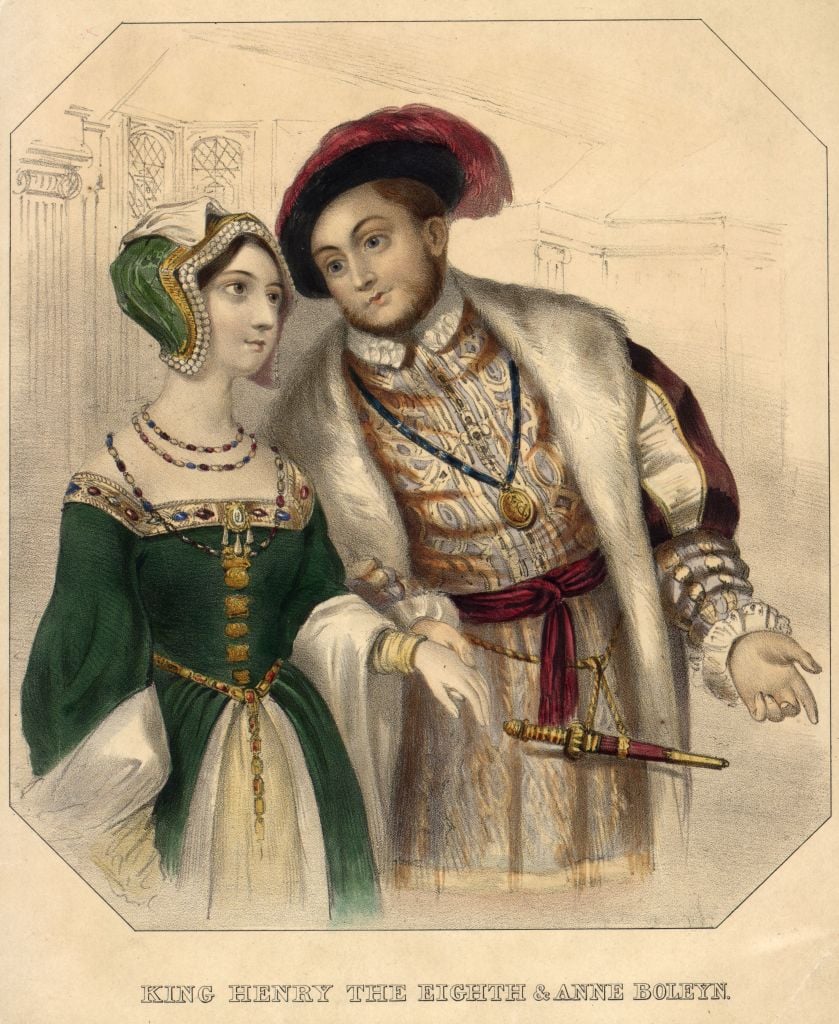What ‘Six’ the Musical Gets Wrong About Anne Boleyn
Six the musical, the story of the wives of England’s King Henry VIII, is now playing on Broadway. In Six, each queen (Catherine of Aragon, Anne Boleyn, Jane Seymour, Anna of Cleves, Katherine Howard and Catherine Parr) get a chance to tell their side of the story–through song and dance. But the most famous of them all is no doubt, Anne Boleyn.
If you know anything about history, you’ll know that the notorious king changed England’s national religion just for his second wife. However, you might not really know why he did that. Or even why he eventually beheaded her. One historian is making the case that modern interpretations of Anne Boleyn (even fictionalized ones, like in Six), are inaccurate.
The narrative on Henry VIII’s most famous wife, Anne Boleyn, is probably way off

“Anne is widely credited as a key factor leading to England’s astounding break with the Roman Catholic Church in 1533,” Time reported. Boleyn was vilified for this at the time. Her peers “painted her as a seductress, as power-hungry, and even as a witch with six fingers who enchanted the king.”
However, the narrative around Henry VIII’s second wife hasn’t caught up with the times–or been read with a contemporary perspective.
“For hundreds of years, Anne Boleyn’s bad reputation has run throughout both conventional historical narratives and popular depictions of this time period,” Time argued.
And they have the receipts:
Look no further than the film The Other Boleyn Girl, in which Natalie Portman portrays Boleyn as a scheming temptress, or the television series Wolf Hall, featuring Claire Foy’s Anne as part of an ambitious and social-climbing family.
The new Broadway musical Six fits nicely into this argument, too.
But now, one historian named Hayley Nolan is attempting to flip the script on Boleyn — by reframing her story as one of victimhood. In other words, Henry VIII’s most infamous wife is hardly the “femme fatale” that many still view her to be.
Of all the king’s 6 wives, Anne Boleyn has the worst reputation
The facts:
Boleyn was arrested along with five men she was accused of committing adultery with — one of whom was her own brother George — in May of 1536. She was tried first and found guilty of adultery, incest and high treason.
However, the accusations that led to her beheading are murky at best.
“Many historians suspect that the charges against Boleyn were at least exaggerated and at worst wholly fabricated,” Time says.
Also, as Nolan mentioned: “the Queen’s lack of privacy and her deeply held religious beliefs would have made it difficult to be unfaithful at all, much less with multiple men.”
Lyrics from ‘Six’ the musical serve this faulty narrative about Anne Boleyn
However, popular culture is still propagating the “temptress” brand in regards to Anne Boleyn. In the musical Six, we see this theme pop up quite a bit.
In the opening song to Six, “Ex-Wives,” Anne Boleyn sings:
I broke England from the Church
Yeah, I’m that sexy

And in her solo, “Don’t Lose Ur Head,”
Politics, not my thing.
OooOoo, but then I met the king
That’s followed by this verse, later in the same Six song:
Henry’s out every night on the town
Just sleepin’ around,
Like what the hell?
If that’s how it’s gonna be,
Maybe I’ll flirt with a guy or three just to make him jel.
Contemporary historians want to cast the Anne Boleyn story in a new light
Nolan says that the interpretation of Boleyn like the one in Six is flat out wrong. She investigated why it still persists today.
“I wanted to get to the truth of why and how Henry could do that to Anne,” Nolan said of Boleyn’s tragic end. “Then in researching him, I discovered that everything we’ve been told about Anne is not the truth.” This has a lot to do with how we recorded stories and events in the past.
“The people who kept the records in the 1500s and the people who interpreted them in the centuries that followed tended to be overwhelmingly male,” Time reported. According to Nolan, they were the people who “brought the perspective that women only achieve power by ‘trickery.'”
For example, as Time brings up: “Much has been made of the love letters Henry VIII wrote to her.” But Nolan argues that “the king had been making inquiries in secret about divorcing Katherine of Aragon years before Boleyn came on the scene.” Not to mention? Anne Boleyn tried to distance herself from Henry VIII.
Boleyn actually resisted the king’s advances. She ran away from the royal court for a year … to escape, and those love letters appear to encompass the time when she was absent from court, distancing herself from his advances.
Anne Boleyn was a victim, not a seductress, historian says
“The historians who do acknowledge this say it was a calculated tactic and sexual blackmail — the ultimate example of ‘when a girl says no, she really means yes,’” Nolan explained. The historian derides the “claim that [Henry VIII] sentenced the queen he loved to death.” It is, after all, steeped in a very problematic belief system.
“I’m sorry, but the manner in which a man kills a woman does not prove his love for her,” Nolan said. “If it can end in decapitation, it was never love.”
Rather than discrediting the victim, Nolan argues, we “need to be defending the victim.” The depiction of Boleyn in Six as “sexy” becomes a bit iffy, through this lens.
“That’s why we can’t dismiss the romanticization of Anne’s story,” she said. “It filters down and has an effect.”
What ‘Six’ the musical and other stories miss: Henry VIII’s second wife was a true politician
In Nolan’s book, Anne Boleyn: 500 Years of Lies, she challenges “the conventional sources often used to explore Boleyn’s life.” But it’s not just her reputation that is off-base. We’ve missed much of what Boleyn actually did to help her country. Thus, the book also points out “the queen’s humanitarian, religious and political efforts.”
For example, not many people know about Boleyn’s participation in passing something called the “Poor Law.”
“Two months before her execution,” Time writes that Boleyn helped pass “nationwide legislation…which stated that local officials should find work for the unemployed.” This is in direct conflict with the concept in Six that Boleyn wasn’t interested in politics.

Nolan told Time why this was so important for people to know.
“She wasn’t a ruthless bully or seductress; she was actually a working politician who died for pushing this radical anti-poverty law through parliament,” she explained.
Okay, okay, so we got a lot of Anne Boeyln’s story wrong. Why does it still matter?
“Correcting Boleyn’s story has broader implications for the way women’s stories are told,” Time reported. Women in politics are still experiencing the negative effects of sexism. While it’s vastly improved since the days of Anne Boleyn, repeating these falsehoods about her (even in musicals, like Six) rise to power doesn’t help women in power today. As Nolan puts it:
We send out a dangerous message to the world when we tell readers and viewers that women only want power for selfish and frivolous reasons. When we tell readers that Anne was killed because she had a string of torrid affairs, it implies that women deserve their downfall.


